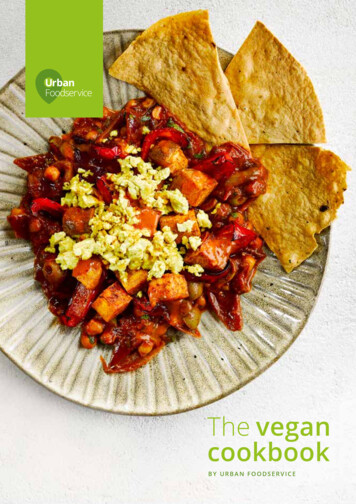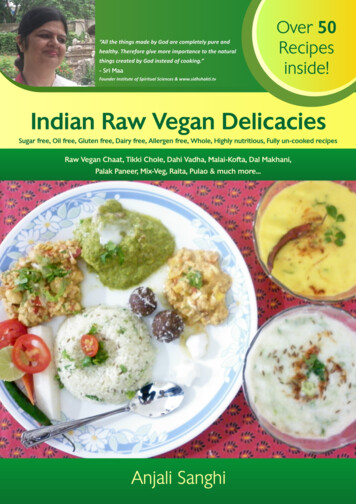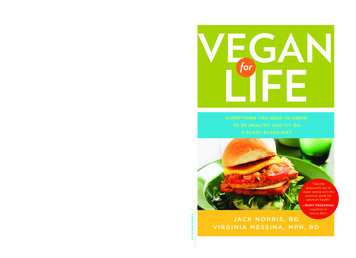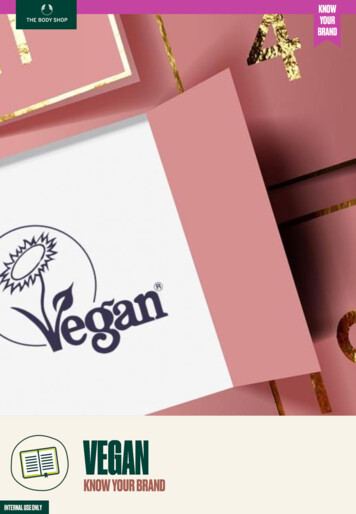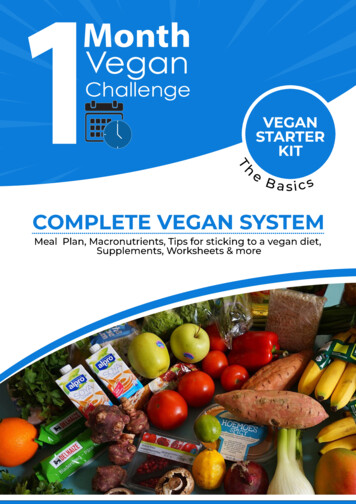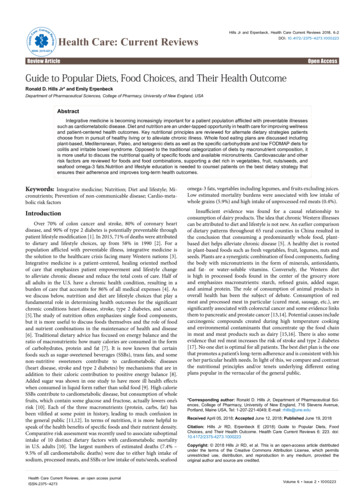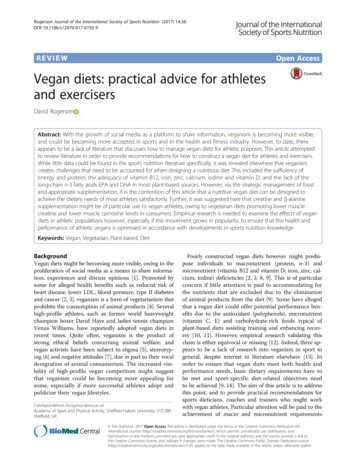
Transcription
Rogerson Journal of the International Society of Sports Nutrition (2017) 14:36DOI 10.1186/s12970-017-0192-9REVIEWOpen AccessVegan diets: practical advice for athletesand exercisersDavid RogersonAbstract: With the growth of social media as a platform to share information, veganism is becoming more visible,and could be becoming more accepted in sports and in the health and fitness industry. However, to date, thereappears to be a lack of literature that discusses how to manage vegan diets for athletic purposes. This article attemptedto review literature in order to provide recommendations for how to construct a vegan diet for athletes and exercisers.While little data could be found in the sports nutrition literature specifically, it was revealed elsewhere that veganismcreates challenges that need to be accounted for when designing a nutritious diet. This included the sufficiency ofenergy and protein; the adequacy of vitamin B12, iron, zinc, calcium, iodine and vitamin D; and the lack of thelong-chain n-3 fatty acids EPA and DHA in most plant-based sources. However, via the strategic management of foodand appropriate supplementation, it is the contention of this article that a nutritive vegan diet can be designed toachieve the dietary needs of most athletes satisfactorily. Further, it was suggested here that creatine and β-alaninesupplementation might be of particular use to vegan athletes, owing to vegetarian diets promoting lower musclecreatine and lower muscle carnosine levels in consumers. Empirical research is needed to examine the effects of vegandiets in athletic populations however, especially if this movement grows in popularity, to ensure that the health andperformance of athletic vegans is optimised in accordance with developments in sports nutrition knowledge.Keywords: Vegan, Vegetarian, Plant-based, DietBackgroundVegan diets might be becoming more visible, owing to theproliferation of social media as a means to share information, experiences and discuss opinions [1]. Promoted bysome for alleged health benefits such as reduced risk ofheart disease, lower LDL, blood pressure, type II diabetesand cancer [2, 3], veganism is a form of vegetarianism thatprohibits the consumption of animal products [4]. Severalhigh-profile athletes, such as former world heavyweightchampion boxer David Haye and ladies tennis championVenus Williams, have reportedly adopted vegan diets inrecent times. Quite often, veganism is the product ofstrong ethical beliefs concerning animal welfare, andvegan activists have been subject to stigma [5], stereotyping [6] and negative attitudes [7], due in part to their vocaldenigration of animal consumerism. The increased visibility of high-profile vegan competitors might suggestthat veganism could be becoming more appealing forsome, especially if more successful athletes adopt andpublicize their vegan lifestyles.Correspondence: d.rogerson@shu.ac.ukAcademy of Sport and Physical Activity, Sheffield Hallam University, S10 2BP,Sheffield, UKPoorly constructed vegan diets however might predispose individuals to macronutrient (protein, n-3) andmicronutrient (vitamin B12 and vitamin D; iron, zinc, calcium, iodine) deficiencies [2, 3, 8, 9]. This is of particularconcern if little attention is paid to accommodating forthe nutrients that are excluded due to the eliminationof animal products from the diet [9]. Some have allegedthat a vegan diet could offer potential performance benefits due to the antioxidant (polyphenols), micronutrient(vitamin C, E) and carbohydrate-rich foods typical ofplant-based diets assisting training and enhancing recovery [10, 11]. However, empirical research validating thisclaim is either equivocal or missing [12]. Indeed, there appears to be a lack of research into veganism in sport ingeneral, despite interest in literature elsewhere [13]. Inorder to ensure that vegan diets meet both health andperformance needs, basic dietary requirements have tobe met and sport-specific diet-related objectives needto be achieved [9, 14]. The aim of this article is to addressthis point, and to provide practical recommendations forsports dieticians, coaches and trainers who might workwith vegan athletes. Particular attention will be paid to theachievement of macro and micronutrient requirements The Author(s). 2017 Open Access This article is distributed under the terms of the Creative Commons Attribution 4.0International License (http://creativecommons.org/licenses/by/4.0/), which permits unrestricted use, distribution, andreproduction in any medium, provided you give appropriate credit to the original author(s) and the source, provide a link tothe Creative Commons license, and indicate if changes were made. The Creative Commons Public Domain Dedication o/1.0/) applies to the data made available in this article, unless otherwise stated.
Rogerson Journal of the International Society of Sports Nutrition (2017) 14:36for athletic and health-related purposes in this article, aswell as a discussion of supplements and ergogenic aidsthat might be of use to performers who adopt this lifestylechoice.Main TextThe information in this narrative has been extrapolatedfrom a broad range of academic disciplines, such as theepidemiological and health sciences, in addition to sportsnutrition literature. This is due to little information beingavailable that discusses or investigates veganism in sportand health and fitness-related contexts. Therefore, insome instances, recommendations provided herein haveyet to be fully authenticated via scientific investigation,and serve as illustrative concepts until further validationcan be undertaken.EnergyFor most athletes, a well-constructed diet (omnivorousor otherwise) should provide sufficient energy in orderto achieve energy balance [15]. However, data suggeststhat a negative energy balance is common in enduranceathletes and athletes participating in weight-making andaesthetic sports (such as combat sports, gymnastics,skating and dancing, etc.) [15]. Very large athletes mightalso find it difficult to achieve energy balance, particularly during high-volume training phases [16, 17]. Ofparticular concern in sports that require low body mass,some female athletes might be at risk of developing lowbone-mineral density [18]. This is likely to be exacerbated by a poorly-constructed hypocaloric diet [18].Additionally, high intensity training can reduce appetite[19], and hectic travel schedules, poor food availability(whilst abroad or away from home) and gastrointestinaldiscomfort might mean that some athletes find it difficult to meet their energy requirements due to variousfactors [17, 20].The consequences of insufficient energy are important.Immunity might become compromised, leading to illnessesand time off from training and competition [15, 21].Weight loss can ensue, and can lead to the loss of musclemass, reduced strength, lower work capacity and a lack ofsatisfactory training adaptation [15]. Managing energybalance is thus important for all athletes, but this issueis likely to be compounded further when a habitual dietpromotes early satiation and reduced appetite, such asa vegan diet [3, 4, 8–11]. Well-accepted methods of calculating energy intake include estimates such as the Cunningham or Harris-Benedict eqs. [22], Dietary ReferenceIntakes (DRIs) and/or other literature-based guidelinescan all be used to determine nutrient needs and design diets [17]. The International Society of Sports Nutrition(ISSN) recommends that energy requirements should bescaled to activity level, body-mass and mode of exercisePage 2 of 15[16], to ensure that individual-specific needs are met [17].Such recommendations are prudent in light of the preceding discussion, as well as the likelihood that athletespossess individual-specific energy and nutrient requirements which differ on the basis of sport, training andcompetition characteristics [15–17].Data indicates that vegans consume less energy thanomnivores [8], and research suggests that vegetarian diets generally appear to be lower in protein, fat, vitaminB12, Riboflavin, vitamin D, calcium, iron and zinc whencompared to an omnivorous diet [8, 14, 23, 24]. Table 1details vegetarian diets as described in the literature, andhighlights how the diets differ based on the extent oftheir restrictions. Some vegan diets promote the consumption of raw foods only, and data suggests that these dietsmight lead to poor macronutrient absorption and weightloss when consumed ad libitum [25]. Vegetarian andvegan diets can also lead to very high fibre consumption [14, 24, 25], and plant-based foods therefore tendto have low energy density and promote early satiety[26]. While these factors might be helpful for weightloss purposes [27], these factors might lead to problemswhen trying to achieve a high Calorie diet. Where ahigh Calorie diet is needed, increasing feeding frequency[28] and increasing consumption of energy dense foodssuch as nuts, seeds and oils [29] might be helpful to ensure that Calorie goals are met. Monitoring and adjustingthe diet on the basis of unwanted body mass fluctuationsin such cases would also allow for diets to be tailored toindividuals’ energy and nutrient requirements [30].MacronutrientsProteinThe role of protein in the athlete’s diet has garnered muchattention over the years, and there has been ongoing debate about whether athletes require greater amounts ofTable 1 Vegetarian Diets: y consumes animal flesh (meat, poultry)and fish, eggs, dairyPesco-vegetarianExcludes animal flesh but does include fishLacto-ovovegetarianExcludes all flesh; includes diary and eggs onlyLacto vegetarianExcludes all flesh and eggs; includes dairy onlyOvo vegetarianExcludes all flesh and dairy; includes eggs onlyVeganExcludes all animal productsMacrobioticvegetarianbVariable dietary restrictions; includes wild meat/game and fish in some variations of the dietFruitarianIncludes fruit, nuts, seeds and a some vegetablesaDefinitions from Phillips 2004 [14]bReaders are advised to exercise caution in their interpretation of Flexitarianand Macrobiotic diets as vegetarian diets; owing to their selective inclusion ofmeat, poultry, fish and seafood, such diets might not be truly vegetarian
Rogerson Journal of the International Society of Sports Nutrition (2017) 14:36protein than non-athletic populations [31–33]. The consensus appears to be that athletes require more proteinthan the lay population [33, 34]. Data also indicates thatprotein requirements should be tailored to reflect sportspecific and training-goal requirements [35–37]. Typicalrecommendations therefore include 1.6–1.7 g kg 1 day 1for strength and power athletes and 1.2–1.4 g kg 1 day 1for endurance-sport athletes—values notably larger thanthe 0.8 g kg 1 day 1 recommended for most non-activeadults [36, 37]. Values as high as 4.4 g kg 1 day 1 havealso been investigated in the literature recently, withfavourable body-composition effects noted as a results ofits composition [38].The role of protein in the athlete’s diet is multifaceted.Protein serves as a substrate for exercise performanceand a catalyst for exercise adaptation [32]. The balancebetween Muscle Protein Breakdown (MPB) and MuscleProtein Synthesis (MPS) is known as Net Protein Balance (NPB). Achieving a positive NPB via elevated MPSpromotes exercise recovery, adaptation and anabolism[32, 38, 39]. During negative energy balance adaptivemechanisms preserve Fat Free Mass (FFM) under hypocaloric conditions [33, 40]. Despite this, dieting athletesand bodybuilders might still require elevated proteinintakes due to the need to preserve lean mass and promote satiety [33, 39]. Concurrent resistance and endurance training might also compound the need for extraprotein during a hypocaloric diet [33, 39]. Athletes involved in weight-categorised and aesthetic sports needto be cognisant of optimizing protein intakes, wherethe preservation of FFM and optimization of relativestrength is likely to be advantageous to performance.The ISSN provides a broad protein recommendation of1.4–2.0 g kg day 1, which is likely to be appropriatefor most athletic contexts [34]. However, for athletes inneed of losing body-mass, recommendations of up to1.8–2.7 g kg day 1 have been provided in literature[33, 39], and values as high as 2.3–3.2 g kg FFM day 1have been suggested for bodybuilders aiming to achievecompetition-level leanness [39].Vegan athletes however appear to consume less proteinthan their omnivorous and vegetarian counterparts [11].The optimisation of protein intakes for vegan athlete requires that attention is paid to the quantity and quality ofprotein consumed [41]. Plant-based protein sources areoften incomplete, missing important essential amino acids,and typically contain less Branched Chain Amino Acids(BCAA) than their animal-based equivalents [34, 35]. Leucine appears to be a primary trigger of MPS, and plays animportant role in promoting recovery and adaptation fromexercise [32, 34, 41]. Interestingly, evidence suggests thatmilk-based proteins might be superior to other proteinsources at promoting MPS, mediated in part by the richness of its BCAA content [42, 43]. Similarly, the habitualPage 3 of 15consumption of milk as part of a diet and resistancetraining programme might lead to better muscle hypertrophy when compared to a soy-protein-supplementedequivalent [44, 45]. This is might be due to milk’s superioramino acid composition [45]. Indeed, plant-based proteinsoften lack essential amino acids [46], and animal-basedproteins therefore possess a greater biological value due tothe presence of all essential amino acids in the food [46].Common examples of the limiting amino acids in plantbased proteins include lysine, methionine, isoleucine,threonine and tryptophan. Of these, lysine appears to beto be most commonly absent, particularly from cerealgrains [46]. Foods such as beans and legumes are richsources of lysine however, and leucine can be obtainedfrom soy beans and lentils. Other BCAAs can be found inseeds, tree nuts and chickpeas, meaning that these aminoacids can be obtained by consuming a variety of proteinrich, plant-based foods [14, 46]. Indeed, the Academy ofNutrition and Dietetics (AND) have recommended that arange of plant-based proteins should be consumed byvegetarians in order to meet their protein and aminoacid requirements [47]. Further, the once-popular recommendation of combining protein sources to achievea complete essential amino acid profile in each feedingis no longer considered necessary [14]. Foods such asgrains, legumes, nuts and seeds should be included inthe vegan diet to ensure that all EAAs are present, andthat adequate BCAA are consumed to support recoveryand adaptation from training. Examples of high-proteinvegan-friendly foods can be found in Table 2.Plant-based protein supplements that feature in the literature and are commercially available include soy (andsoy isolate), pea, rice, hemp and composite/blended protein products [45–48]. Supplemental protein might be ofinterest to vegan athletes, particularly if achieving sufficientprotein via wholefoods is either difficult or inconvenient.Emerging data is beginning to support the efficacy ofplant-based-protein powders at improving recovery fromtraining [48] and fostering muscle hypertrophy as part of aresistance training program [45]. Recent evidence also suggests like-for-like responses when comparing supplementalTable 2 High Protein FoodsFoodProtein per 100 gaPumpkin seeds (dried, uncooked)30.2Lentils (red, split, uncooked)24.6Black beans (uncooked)21.6Almonds (raw)21.2Tempeh20.3Tofu (calcium set)17.3Oats (rolled)16.9Quinoa (uncooked)14.1aData from USDA food composition database SR28
Rogerson Journal of the International Society of Sports Nutrition (2017) 14:36plant and dairy proteins on body composition and exerciseperformance as part of a training programme [48], contrasting previously-reported data [45]. In comparison todairy-based protein supplements however, plant-based supplements appear to be much less researched at this time,and further research is needed to understand the effects ofindividual (rice, pea, hemp, etc.) and blended products onpostprandial MPS [49].Protein digestibilityThe digestibility of plant-based protein appears to bemarkedly less than that of animal products, which mightneed to be accounted for when designing a vegan diet[50]. The Protein Digestibility Corrected Amino AcidScore (PDCAAS) and Digestible Indispensable AminoAcid Score (DIAAS) are metrics that rate the quality ofproteins based on their digestibility [51]. The PDCAAShas been criticised for disregarding anti-nutrient factorsthat affect protein absorption, and for truncating proteinsources that score in excess of its 1.0 ceiling [51]. TheDIAAS does neither, and is perhaps a superior systemfor rating protein digestibility [41, 51]. Both systemshowever indicate that animal-derived proteins scorehigher than plant-based sources [51]. Interestingly, soyprotein possesses a PDCAAS of 1.0 and appears to becomparable to whey protein isolate. However, when factoring in anti-nutrient factors such as phytic acid andtrypsin inhibitors, which limit the absorption of nutrients,whey protein isolate appears to be superior to soy proteinwhen using the DIAAS (1.09 vs. 0.91) [41]. Other important plant-based protein sources such as rice, peas andhemp all score markedly lower than animal-basedsources such as eggs, chicken and beef using either system[41, 51, 52]. Indeed, it has been suggested that vegetariansmight need to consume more protein than meat eaters tocompensate for the poorer digestibility of plant-basedsources [50]. Values of up to 1.0 g kg 1 day 1 (vs. theRDA’s 0.8 g kg 1 day 1) have been suggested for a nonathletic, vegetarian population, who might consume eggsand dairy products in addition to plant-based proteins[50]. Due to the absence of all animal proteins in the diet,it might be prudent for vegan athletes to aim for proteinintakes towards the higher end of the ISSN’s protein recommendation of 1.4 to 2.0 g kg day 1, whilst in anenergy-neutral or energy-positive state. In some instances,values of up to 1.8 g kg 1 to 2.7 g kg day 1 might beappropriate during weight loss phases, to compensatefor the reduced digestibility and low biological value ofplant-based sources [33, 39].CarbohydrateVegan diets tend to be higher in carbohydrates, fibre,fruits, vegetables, antioxidants and phytochemicals thanomnivorous diets [53]. The consumption of micronutrientPage 4 of 15and phytochemical-rich foods is an important benefit ofany plant-based diet [3, 9]. This might help to mitigate theeffects of excess inflammation and promote recovery fromtraining, although this has yet to be confirmed empirically[10, 12]. It has been suggested that some endurance athletes might intentionally adopt a vegan diet in order tomeet their carbohydrate needs, or to assist weight management goals [10, 11, 54]. Carbohydrate requirements insport has been the focus of literature debate for some time[55], and athletic diets generally require carbohydrate intakes of 4 to 12 g kg 1 to support high training volumes,depending on the mode of exercise, the athlete’s genderand goal of the athlete’s diet [17].Achieving an adequate carbohydrate intake via a vegandiet is relatively straightforward, and grains, legumes,beans, tubers, root vegetables and fruits can all be consumed to meet carbohydrate requirements satisfactorily.In order to achieve sufficient protein via the consumption of whole foods as recommended in this article, it isrecommended that vegans consume beans, pulses, lentilsand grains daily—foods that are also abundant in carbohydrate. However, recall that these foodstuffs are richsources of fibre. Fibrous, non-digestible carbohydratesand lignin provide volume and bulk, are resistant to digestion and absorption, and promote early satiation andenhance prolonged satiety signalling [47, 56, 57]. Forathletes requiring higher energy intakes, the consumption of fibre-rich foods to achieve protein and carbohydrate adequacy might prove to be difficult for some. Dueto the lectins in foods such as beans, grains, nuts andpotatoes [58], as well as the fermentation of resistantstarch and indigestible carbohydrates (found in oats, peas,beans, fruits, and in certain vegetables and lentils), a highfibre diet can also promote gastric distress in somecases [38, 59, 60]. In order to achieve sufficient carbohydrate for the athletes involved in high-volume training phases it might be appropriate (in some contexts)to choose some lower-fibre foods when developinghigh-carbohydrate meals, as long as sufficient micronutrient status (particularly B vitamins) can be ensured.Foods such as rice, pasta, noodles and buckwheat containless fibre than oats, lentils, beans and wholegrain breads,and removing the skin from tubers and root vegetables reduces the fibre contents of these foods whilst maintainingdecent carbohydrate levels.Carbohydrate timing and supplementationThe optimisation of carbohydrate consumption with respect to training and competition has been debated inthe literature [61]. Conventional wisdom suggests thatmaintaining high muscle glycogen stores (achieved via acarbohydrate-rich diet), consuming carbohydrates beforeand during exercise (scaled to absolute intensity andmode of exercise), consuming multiple-transportable
Rogerson Journal of the International Society of Sports Nutrition (2017) 14:36carbohydrates (such as a glucose-fructose mixture), andcarbohydrate mouth rinsing (to delay fatigue) might enhance performance during middle-distance and enduranceevents [37, 62]. The effects of carbohydrate consumptionbefore and during short-duration high-intensity sports areequivocal [36], however carbohydrate feedings 0–60 minprior to exercise have been indicated for events lasting 30 mins [37, 62]. Carbohydrate doses during activity canbe scaled based on the event, where more/less carbohydrate is consumed with respect to the time and intensityof sport/exercise performance [37, 62]. In most cases,carbohydrate supplements appear to be vegan-friendly,and so their consumption is feasible for most vegan athletes. Consuming calcium-fortified fruit juices as a liquidcarbohydrate might serve dual purposes however, and enable vegans to meet both carbohydrate and calcium needswhilst concomitantly offering possible ergogenic advantages if used as indicated in the literature [61].FatVegan diets are typically lower in total and saturated fatand higher in n-6 fats than omnivorous and vegetariandiets [8, 13, 63]. This trend appears to be associated withreductions in heart disease, hypertension, type II diabetes, cholesterol and cancer [63], and is a purportedhealth benefit of veganism. However, the role of fat inthe diet is an area of much discussion, and deleteriouseffects of fat consumption are not universally accepted[64–66]. Indeed, in some cases, high-fat diets have evenbeen promoted [55]. Interestingly, research has indicatedthat low-fat dieting might negatively influence testosterone levels in males [67]. This might be of interest to athletes needing to maximise anabolism and adaptation toresistance training. However, despite reporting lowertotal and saturated fat intakes, evidence has also suggestedthat vegan males do not have statistically lower androgenlevels than omnivores [68]. Relationships between fat consumption, hormones and sport performance might requireadditional investigation. In many instances, it appearsthat the health implications of a dietary fat might reflect its fatty acid composition [64, 69], meaning thatattention should be paid to the quantity and qualityof fat consumed. Achieving recommended values of0.5–1.5 g kg day 1 (or 30% of daily caloric intake) isfeasible for vegan athletes given adequate consumption ofoils, avocados, nuts and seeds.ALA, EPA and DHADue to an absence of marine-sourced fats, vegans appearto consume fewer n-3 fatty acids and possess lowerserum n-3 fatty acid levels than omnivores and othervegetarians [8, 13, 63, 70]. This might have importanthealth and performance implications. The n-3 fatty acidsare important for normal growth and development, andPage 5 of 15appear to play an important role in cardiovascular health[71], in inflammatory and chronic disease [72], and mightimprove exercise-induced bronchoconstriction (EIB) andimmunity [73]. Of interest to athletes, n-3 fats might alsoincrease nitric oxide production [71, 74], and improveheart-rate variability [75]. Both n-6 and n-3 fatty acids areparent fatty acids for eicosanoids (prostaglandins, thromboxanes and leukotrienes), and n-3 fatty acids appear topossess anti-inflammatory, antithrombotic, antiarrhythmic; hypolipidemic, vasodilatory and antiproliferativeproperties [71, 72]. Both n-6 and n-3 fatty acids are essential, however the long chain n-3 fatty acids eicosapentaenoic acid (EPA) and docosahexaenoic acid (DHA) areconsidered to be under-consumed in the modern westerndiet in general [72], and in vegans in particular [47, 70].There is ongoing debate about the quantity and/orratio of n-3 to n-6 needed to manipulate the synthesisof pro and anti-inflammatory eicosanoids in order toimpact health and performance favourably [76–78]. Inthe UK, an upper limit of 10% of energy from proinflammatory n-6 fatty acids has been recommendedby the Department of Health to reduce negative effectsof overconsumption [78]. Elsewhere, Sanders [79] andPhilips [14] recommend that vegetarian diets limitlinoleic acid consumption (an n-6 fatty acid), found insunflower, corn and safflower oils, for similar purposes.The n-3 α-linolenic acid (ALA) is an important constituent of cellular membrane and is converted to EPAat 8% efficiency in humans, which appears to be bothage and gender-specific in magnitude [80]. Roughly0.5% of ALA is converted to DHA, highlighting humans’poor ability to enzymatically convert ALA to this fatty acid[81]. While humans do convert a small amount of ALA toDHA, the primary source of this in the diet is cold waterfish and seafood. EPA and DHA exert many of the reported health and performance benefits of n-3 fatty acidconsumption and is now a popular supplement [80]. Supplemental ALA has been shown to increase blood EPAlevels [82] but does not appear to affect DHA status [83].Microalgae oil is rich in DHA (and EPA) and might bea useful supplement for vegans and vegetarians.Microalgae-oil supplements have been shown to raiseboth blood EPA and DHA levels [84]. However, recommendations for vegan-friendly DHA supplements donot appear in the literature at this time [9]. Recommendations do appear for other food sources of the n-3 ALA,such as flax seeds, walnuts, and chia seeds [9, 14]. Interestingly, flax/linseeds are also rich in lignan precursors,which might offer broader health-related benefits [85], andchia is also a complete protein [86]. Combining whole-foodsources of ALA as indicated in this article with supplemental DHA derived from microalgae oil might optimise avegan’s n-3 fatty acid intake, and improve health concurrently with any health and performance-enhancing effect
Rogerson Journal of the International Society of Sports Nutrition (2017) 14:36that augmented n-3 diets might offer athletes [76, 77].Research detailing how to optimise n-3 consumption forvegans is missing at the time of writing; however, recommendations of 1–2 g day 1 of combined EPA and DHAat a ratio of 2:1 have been suggested for athletes elsewhere[77]. To achieve a DHA dose of 500 - 1000 mg day 1, thiswould equate to 1–2 g of microalgae oil, or 2–4 capsulesin most commercial products.MicronutrientsAchieving micronutrient sufficiency is an important concern for all athletes. The AND have indicated that attention should be paid to achieving adequacy in vitaminB12, iron, zinc, calcium, iodine and vitamin D intakeswhen designing a vegan diet in particular [47]. Poorlydesigned diets might predispose individuals to deficiencyregardless of predilection, which could have detrimentalhealth and performance implications [2, 9, 12]. This needsto be understood by those seeking to adopt veganism, andstrategies to mitigate the risks of under-consuming thesenutrients need to be present if a vegan diet is tooptimize health and performance. Table 3 compares thenutritional implications of several diets (omnivorous,pesco-vegetarian, vegetarian and vegan), and providesrecommendations for athletes and practitioners. Thefollowing section will identify and elaborate upon concerns highlighted in the literature, based upon researchindicating what micronutrients might be under-consumedin a vegan diet [2–4, 8, 14, 47, 63, 70, 87].Vitamin B12Due to an absence of animal and dairy products, vegansare at an increased risk of developing Vitamin B12(cobalamin) deficiency [87]. Cobalamin is synthesisedfrom anaerobic microorganisms, in the rumen of cattleand sheep, and humans typically consume pre-formedcobalamin from animal products, which are the mainsource of B12 in the diet [88]. Plant-based sources ofcobalamin are unusual, unless the plant has been contaminated by manure or from animal waste [47, 88].Cobalamin is essential for normal nervous system function, homocysteine metabolism and DNA synthesis [88].Insufficient cobalamin can lead to morphological changesto the blood cells and the development of haematologicaland neurological symptoms, such as megaloblastic anaemia and neuropathy [89]. Long-term cobalamin deficiency can lead to irreversible neurological damage, anddata indicates that veganism can lead to deficiency ifcobalamin is not supplemented [14]. Data from theEPIC-Oxford cohort study in the UK indicated that 50% of vegan participants were vitamin B12 deficient[90]. An additional 21% of the vegans were also classified as having very low levels
Venus Williams, have reportedly adopted vegan diets in recent times. Quite often, veganism is the product of strong ethical beliefs concerning animal welfare, and vegan activists have been subject to stigma [5], stereotyp-ing [6] and negative attitudes [7], due in part to their voc
